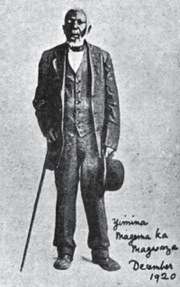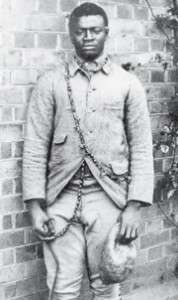BLACK SOCIAL HISTORY Magema M. Fuze
Just over eighty years later, he became the first Zulu writer to publish a book in Zulu. This book is called ‘Abantu Abamnyama’. The book is now also in English and is called ‘The Black People and whence they came’. He had a friend called Mr M.J. V. Masuku. With “large teardrops” in his eyes, Mr Masuku begged Magema to write the book. Magema later said that he agreed to write the book, “In order that our children might know where we came from.” He did this even though he was very weak and almost eighty.
In his book he talks about where black people come from and about Zulu customs. Most of the book is about Zulu history. He talks about the Zulu kings and their lives. He talks about how the British people took over Zululand, and about all the fighting that happened after that when the British people divided up Zululand.
When Magema was a small boy, he spoke many times about a man who would come from across the sea, and who would be his teacher. He said that this man would call him ‘Skelemu’. His mother and father looked at their small child playing with his toy carts and stones and aloe leaves, and did not understand what he was saying. But soon people began to call him Skelemu.
Then one day, when Magema was still a small boy, Bishop Colenso arrived in Natal from England. He wrote to all the chiefs, and he said that all children who were beginning to lose their first teeth should be gathered together and educated at his school.
Many of the chiefs did not trust Bishop Colenso, but Skelemu’s father said that this must be the man Skelemu often spoke about, and Skelemu must go to him.
So Skelemu went to school at Ekukhanyeni, which was the place where Bishop Colenso lived. Bishop Colenso was called Sobantu by all those people who knew him. A few years later, while Skelemu was still living at Ekukhanyeni, he learnt how to print books on Bishop Colenso’s printing press. He was one of the first black people in South Africa to learn this skill.
Skelemu was baptised by Bishop Colenso when he was about twenty years old. That is when he changed his name to Magema, and so he was no longer to be called Skelemu. But he did not let Christianity separate him from his people. He stayed closely in touch with Zulu culture and customs all his life.
He continued to live at Ekukhanyeni. In 1878, just before Isandhlwana, when the British people invaded Zululand, he went to visit King Cetshwayo to deliver a message from Bishop Colenso. At last he and his friends arrived at Ezinhlendleni,which was the name of the place where the King lived. They stayed for ten days.
Magema saw the king and spoke to him two days after he arrived. Magema said that the king was very handsome and kind and worried about his people. He wrote in his book that King Cetshwayo was “good and kind and loved by all his people”.
He also said, “I first heard from the king on that day that the white people were about to invade Zululand.” King Cetshwayo ordered two of his men to travel back to Natal with Magema and his friends to make sure they arrived back home safely. He also wanted his men to pay his respects to Bishop Colenso. King Cetshwayo gave Magema and the other men food for the journey. On their way home they stopped at Magema’s father’s home at Mahlaba. They gave his mother two sheep from the King, and rested for a few days.
About ten years later, after the war and after King Cetshwayo had died, Magema went to stay in Eshowe. King Cetshwayo’s brothers and his son, Prince Dinuzulu, were in jail there. They were put in jail by the Government. Magema stayed in Eshowe so that he could teach Prince Dinuzulu reading and writing.
In January 1890 Prince Dinuzulu and his uncles heard that the Government wanted to send them to the island called St. Helena. “Wo!,” wrote Magema, “there was confusion among us, speaking in low voices about that.” Magema wrote to Manzekofi (Harry Escombe — their lawyer) telling him about where Prince Dinuzulu and his uncles were going.
So Prince Dinuzulu and his uncles went to St. Helena, and Magema went back to Pietermaritzburg. He worked at St. Alban’s College, teaching the pupils about printing. Six years later, Prince Dinuzulu sent him a message to come to the island of St. Helena to teach his five children.
He went there and found that Prince Dinuzulu and his family were not kept in a jail on St.
Helena. The Governor of the island had parties and invited Prince Dinuzulu and his wives. Prince Dinuzulu also had parties with dancing and lots to eat. But he was not allowed to leave the island.
While Magema was on the island, he wrote a few very angry letters to the Governor of St. Helena and to the Commissioner for Zululand in Eshowe.
He was angry because someone was opening his letters and reading them before he got them. This always happened if a letter came from Bishop Colenso’s daughter, Harriette, whom he called Dlwedlwe. He called her Dlwedlwe because she was thin and tall like a stick.
One night on St Helena, Magema fell down a high cliff and broke his ankle. He wrote, “The cliff is very high, and I think that by the time I reached the bottom, I was long since unconscious. When I recovered consciousness and tried to get up, I was unable to do so, and I wondered what had happened to me. After a long time I made a great effort to get up. Wo! It was not possible because the bone was broken, the foot lying sideways to the ankle! Well! What was I to do seeing that it was so late and also dark?” Luckily, he soon heard people talking at the top of the cliff, so he shouted, “Hello!” They shouted, “Who are you?” Magema replied, “I am a dead man.“ They were two soldiers and they quickly went to get help.
Prince Dinuzulu tried to get permission for Magema to come to his house to be cared for by his doctor. When the prince didn’t get permission, he just came to the hospital and took Magema away.
About nine months later Harriette arrived at St. Helena. She had struggled for many years to get permission for Prince Dinuzulu to return home.
Now she had the permission and they all left on the ship, the S.S. Umbilo, on the day before Christmas. They arrived back home early in January 1898.
Magema and Harriet stayed close friends until he died. It is not clear exactly how old he was when he died. In 1922, when he must have been about eighty-two years old and very weak, he wrote, “I will be happy if the one above will allow me to proceed with my work in spite of my present frailty which makes me realise when I walk that the times have advanced! How is it that my knees are so rickety when I walk!” He did finish his book, and that same year it was published.













































No comments:
Post a Comment